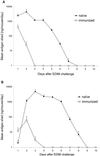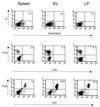CD4 T cells are the only lymphocytes needed to protect mice against rotavirus shedding after intranasal immunization with a chimeric VP6 protein and the adjuvant LT(R192G)
- PMID: 11752147
- PMCID: PMC136815
- DOI: 10.1128/jvi.76.2.560-568.2002
CD4 T cells are the only lymphocytes needed to protect mice against rotavirus shedding after intranasal immunization with a chimeric VP6 protein and the adjuvant LT(R192G)
Abstract
Intranasal immunization of mice with a chimeric VP6 protein and the mucosal adjuvant Escherichia coli heat labile toxin LT(R192G) induces nearly complete protection against murine rotavirus (strain EDIM [epizootic diarrhea of infant mice virus]) shedding for at least 1 year. The aim of this study was to identify the protective lymphocytes elicited by this new vaccine candidate. Immunization of mouse strains lacking one or more lymphocyte populations revealed that protection was dependent on alphabeta T cells but mice lacking gammadelta T cells and B cells remained fully protected. Furthermore, depletion of CD8 T cells in immunized B-cell-deficient mice before challenge resulted in no loss of protection, while depletion of CD4 T cells caused complete loss of protection. Therefore, alphabeta CD4 T cells appeared to be the only lymphocytes required for protection. As confirmation, purified splenic T cells from immunized mice were intraperitoneally injected into Rag-2 mice chronically infected with EDIM. Transfer of 2 x 10(6) CD8 T cells had no effect on shedding, while transfer of 2 x 10(5) CD4 T cells fully resolved shedding in 7 days. Interestingly, transfer of naive splenic CD4 T cells also resolved shedding but more time and cells were required. Together, these results establish CD4 T cells as effectors of protection against rotavirus after intranasal immunization of mice with VP6 and LT(R192G).
Figures





References
-
- Arulanandam, B. P., R. H. Raeder, J. G. Nedrud, D. J. Bucher, J. Le, and D. W. Metzger. 2001. IgA immunodeficiency leads to inadequate Th cell priming and increased susceptibility to influenza virus infection. J. Immunol. 166:226–231. - PubMed
-
- Bernstein, D. I., and R. L. Ward. 1998. Rotaviruses, p1901–1921. In R. D. Feigin and J. D. Cherry (ed.), Textbook of pediatric infectious disease, 4th ed. W. B. Saunders, Philadelphia, Pa.
-
- Blumberg, R. S., W. I. Lencer, X. Zhu, H.-S. Kim, S. Claypool, S. P. Balk, L. J. Saubermann, and S. P. Colgan. 1999. Antigen presentation by intestinal epithelial cells. Immunol. Lett. 69:7–11. - PubMed
-
- Burns, J. W., M. Siadat-Pajouh, A. A. Krishnaney, and H. B. Greenberg. 1996. Protective effect of rotavirus VP6-specific IgA monoclonal antibodies that lack neutralizing activity. Science 272:104–107. - PubMed
Publication types
MeSH terms
Substances
Grants and funding
LinkOut - more resources
Full Text Sources
Other Literature Sources
Medical
Research Materials

